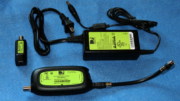If there ever was a clearer case of “don’t try this at home…” well I haven’t seen it. This story is true. As they used to say in old TV shows, some details have been changed to protect the innocent.
I was recently asked if it was ok to run a coaxial cable through a swimming pool. Apparently, this guy wanted to have DIRECTV programming out on the other side of his large backyard, too far for a wireless signal from his Genie 2. The easiest way, he figured, was a straight line. This straight line, apparently, went straight through the pool.
Does it seem like you should do this?
Coaxial cable is designed to be water-resistant, for sure. The rubber outer jacket should stop water from coming in. Coax cables work in the rain. They work in the snow. Burial-grade RG6 even works in the dirt. But does it work in a pool?
Actually it does, at least for short periods, I’m just not saying you should do it. Over the short term, you won’t see any issues. However, over time the chlorine in the pool water will eat away at the outer jacket. If there is the slightest nick in that outer jacket, water will get in and ruin the cable.
Even if there wasn’t any chlorine, other minerals would eventually cause the outer jacket to fail, although perhaps not as quickly.
Is electrocution a problem?
Of all the reasons you shouldn’t run coax cable through the pool, electrocution isn’t really the biggest consideration. In most cases the cable will carry maybe 21 volts max, and that’s not enough to electrocute anyone in a pool. Again, the rubber sheath should stop that electricity from going into the water anyway. That is, until the rubber sheath begins to fail.
So why should you not do this?
Well first of all it’s just not a smart idea to run any wire through a pool. It’s not designed for it. The chlorine in the water could eat through the cable eventually, and unless you secure it really well, what’s going to happen is that someone will yank on it, pulling your receiver and TV into the pool. When that happens, no one wins.
But, here’s the thing I found a bit surprising when I tested this (as safely as I could.) Coaxial cable floats. I guess I should have expected it, given that the white dielectric is full of air. But yeah it floats. What’s worse is that it doesn’t really float on the surface. It’s too heavy for that. It sort of sits there about five feet down which is really, really unsafe. I’m just saying, do not do this, it’s just a recipe for disaster. I can imagine all sorts of bad things happening if people are in a pool with a cable running through the middle of it.
What’s a better option?
If you need to get coaxial cable out to the back patio and you have a Genie DVR, the best thing to do is run cable out to a covered patio and connect it to a wireless video bridge. From there you can run a wireless Genie client about 50 feet which is going to cover you unless you’re incredibly rich. This works even if you have a Genie 2 which has its own video bridge. The client will just connect to the bridge which has a stronger signal.
If you have other questions about special installations, call the experts! No one does more custom home installs for satellite TV than we do. Call us at 888-233-7563 during East Coast business hours. If it’s after hours, no problem! Fill out the form below. We’ll get right back to you.





